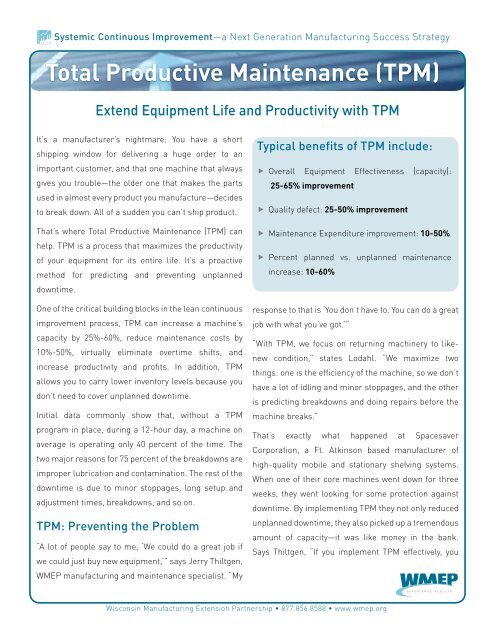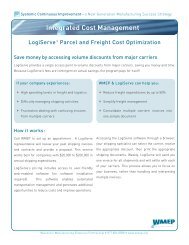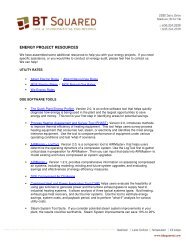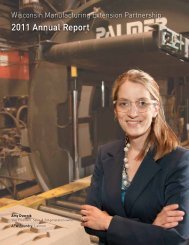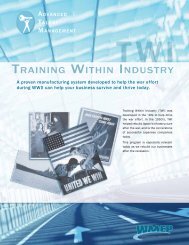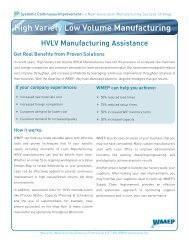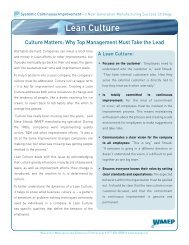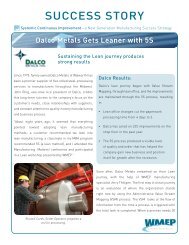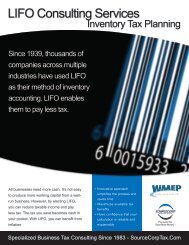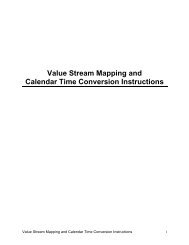Total Productive Maintenance (TPM) - Wisconsin Manufacturing ...
Total Productive Maintenance (TPM) - Wisconsin Manufacturing ...
Total Productive Maintenance (TPM) - Wisconsin Manufacturing ...
Create successful ePaper yourself
Turn your PDF publications into a flip-book with our unique Google optimized e-Paper software.
LEANERSystemic Continuous Improvement—a Next Generation <strong>Manufacturing</strong> Success Strategy<strong>Total</strong> <strong>Productive</strong> <strong>Maintenance</strong> (<strong>TPM</strong>)Extend Equipment Life and Productivity with <strong>TPM</strong>It’s a manufacturer’s nightmare: You have a shortshipping window for delivering a huge order to animportant customer, and that one machine that alwaysgives you trouble—the older one that makes the partsused in almost every product you manufacture—decidesto break down. All of a sudden you can’t ship product.That’s where <strong>Total</strong> <strong>Productive</strong> <strong>Maintenance</strong> (<strong>TPM</strong>) canhelp. <strong>TPM</strong> is a process that maximizes the productivityof your equipment for its entire life. It’s a proactivemethod for predicting and preventing unplanneddowntime.One of the critical building blocks in the lean continuousimprovement process, <strong>TPM</strong> can increase a machine’scapacity by 25%-60%, reduce maintenance costs by10%-50%, virtually eliminate overtime shifts, andincrease productivity and profits. In addition, <strong>TPM</strong>allows you to carry lower inventory levels because youdon’t need to cover unplanned downtime.Initial data commonly show that, without a <strong>TPM</strong>program in place, during a 12-hour day, a machine onaverage is operating only 40 percent of the time. Thetwo major reasons for 75 percent of the breakdowns areimproper lubrication and contamination. The rest of thedowntime is due to minor stoppages, long setup andadjustment times, breakdowns, and so on.<strong>TPM</strong>: Preventing the Problem“A lot of people say to me, ‘We could do a great job ifwe could just buy new equipment,’” says Jerry Thiltgen,WMEP manufacturing and maintenance specialist. “MyTypical benefits of <strong>TPM</strong> include:ffOverall Equipment Effectiveness (capacity):25-65% improvementffQuality defect: 25-50% improvementff<strong>Maintenance</strong> Expenditure improvement: 10-50%ffPercent planned vs. unplanned maintenanceincrease: 10-60%response to that is ‘You don’t have to. You can do a greatjob with what you’ve got.’”“With <strong>TPM</strong>, we focus on returning machinery to likenewcondition,” states Lodahl. “We maximize twothings: one is the efficiency of the machine, so we don’thave a lot of idling and minor stoppages, and the otheris predicting breakdowns and doing repairs before themachine breaks.”That’s exactly what happened at SpacesaverCorporation, a Ft. Atkinson based manufacturer ofhigh-quality mobile and stationary shelving systems.When one of their core machines went down for threeweeks, they went looking for some protection againstdowntime. By implementing <strong>TPM</strong> they not only reducedunplanned downtime, they also picked up a tremendousamount of capacity—it was like money in the bank.Says Thiltgen, “If you implement <strong>TPM</strong> effectively, you<strong>Wisconsin</strong> <strong>Manufacturing</strong> Extension Partnership • 877.856.8588 • www.wmep.org
<strong>Total</strong> <strong>Productive</strong> <strong>Maintenance</strong>can have machines that run at their rated capacityfor their entire life in the factory—and the life of themachines will be increased by the attention they’regetting.”The <strong>TPM</strong> Process and OEEA <strong>TPM</strong> project typically uses a modified kaizen formatand can span several weeks.ffTraining: A team of people is selected, includingmachine operators, craft maintenance people,supervisors, and management. The processbegins with a day of training, simulationsand case studies, plus instruction on how towork in teams. The team also learns how tocollect Overall Equipment Effectiveness (OEE)data, a simple but very powerful <strong>TPM</strong> tool.OEE is shop floor-collectable data that documentshow long a machine is actually running, howlong it’s down, how many reworks are needed,and so on. OEE provides an easily applied andunderstandable way of measuring machineutilization. It also serves as a record over time ofa machine’s performance and can be used overand over again as a reference guide for futuretroubleshooting. The <strong>TPM</strong> team then decideswhich equipment to target first for improvement.ffOEE Data Collection: During the next three weeks,the first OEE data is collected. This is done by themachine operators themselves, on all shifts. Thisdata serves as baseline data for the project andshows where the problems lie.ffOEE Data Analysis/Problem Prioritization: Theteam meets to analyze the OEE data and prioritizethe problems it uncovers. The problems can becategorized according to the “six big losses” thatreduce a machine’s efficiency: breakdowns, setupand adjustment loss, idling and minor stoppages,reduced speed, defects and rework, and startupand yield loss. From there, the root causes ofthese problems can be targeted and corrected.ff<strong>TPM</strong> Implementation: Next the team works torestore the equipment to make it as reliable andproductive as it is capable of being. Using the OEEdata, high failure rate areas are identified andthe necessary repairs performed. Then daily andperiodic maintenance schedules are established.A 5S factory organization and cleanup project is alsopart of the <strong>TPM</strong> process. Up to 75 percent of unplanneddowntime on machines is caused by contamination orimproper lubrication. By keeping the machines clean,contamination and leaks are easily identified and canbe corrected immediately.“At the end of six weeks, the major causes ofdowntime and degrading of capabilities have beenrepaired, and the speed and reliability of the machineis restored to like-new condition. We can dramaticallyshow the increase in equipment uptime,” Thiltgensays. To document progress and improvement, theteam continues to collect and analyze OEE data fromthe equipment.
<strong>TPM</strong>Making it WorkUsing a team of people from the shop floor up –machine operators, craft maintenance people,supervisors, and management– is critical. The teamprocess is integral to the success of <strong>TPM</strong>, and teamtraining is an important element.Initially, there may be some resistance to <strong>TPM</strong> becauseit changes the way things have been done for manyyears. Machine operators now have responsibility forthe daily maintenance of their machines, after beingtold for years not to touch them except to produceparts. And the maintenance people feel their territoryis being threatened.About WMEPWMEP is a private, nonprofit consulting organizationcommitted to the growth and success of <strong>Wisconsin</strong>manufacturers. A leader in Next Generation<strong>Manufacturing</strong>, WMEP brings best practices to<strong>Wisconsin</strong> firms to help them achieve world-classperformance through innovation and transformation.WMEP receives financial support from the <strong>Wisconsin</strong>Department of Commerce, and partners with manypublic and private organizations to serve <strong>Wisconsin</strong>manufacturers.To learn more about how <strong>TPM</strong> can help yourcompany, call WMEP at 1.877.856.8588.But the operators eventually realize that they gaina lot more ownership in the process and their jobsrun much more smoothly with fewer breakdowns andstoppages. And the maintenance people realize thatthey need to save their skills and knowledge for workon major overhauls and revisions to machines, andfor coaching the operators on daily maintenance.“The motivating thing about all this is instantgratification,” says Thiltgen. “In every <strong>TPM</strong> project I’vedone so far, the team has been so excited about theresults that they wanted to start the second projectbefore we’ve finished the first.”<strong>Wisconsin</strong> <strong>Manufacturing</strong> Extension Partnership • 2601 Crossroads Drive, Suite 145 • Madison WI 53718-7923 • www.wmep.org


